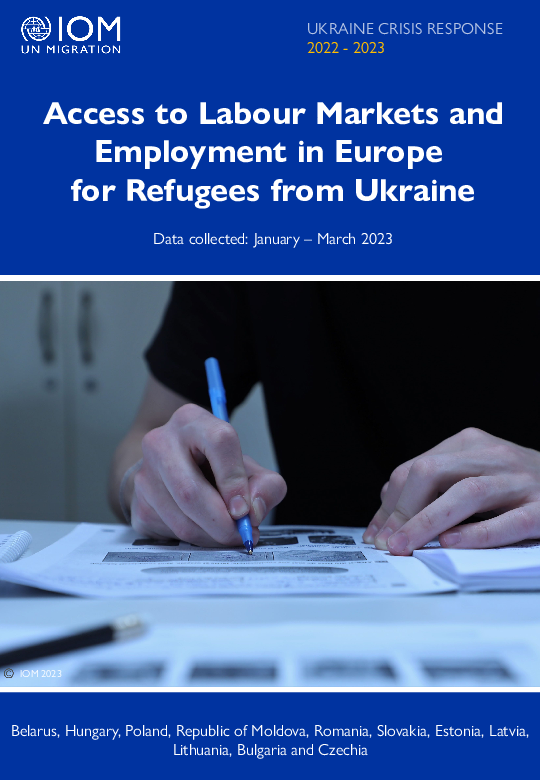-
Countries
-
Data and Analysis
-
Special Focus
-
Crisis Responses
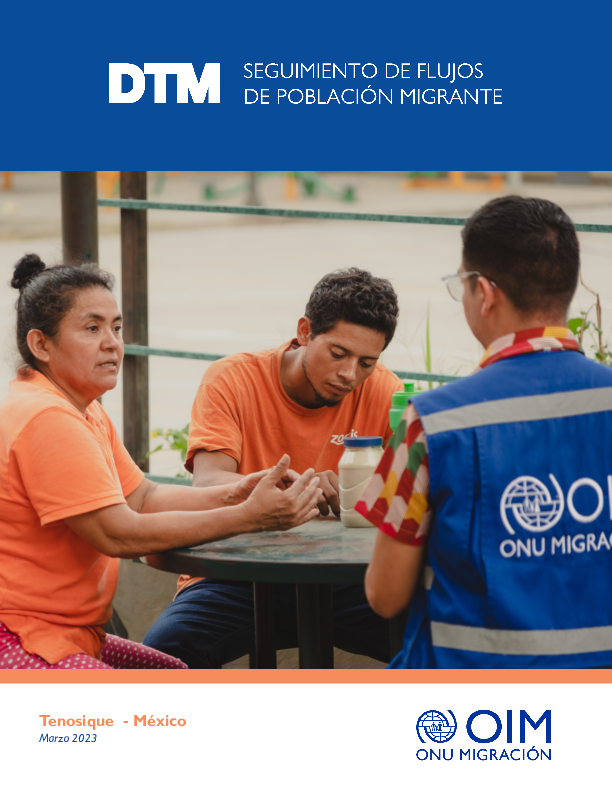
Contact
iommexicodtm@iom.int
Language
Spanish
Location
Mexico
Period Covered
Mar 01 2023
Mar 31 2023
Activity
- Flow Monitoring
- Event Tracking
En este ejercicio se consideran Tenosique, Tabasco y Tapachula, Chiapas durante el mes de marzo 2023. La presente DTM se enmarca en los esfuerzos generados desde el Diccionario Regional y Global de datos a fin de guiar la programación de respuestas en terreno basada en datos confiables, actualizados y comparables a nivel regional. Se seleccionaron los municipios de Tenosique y Tapachula por ser de los principales puntos por los que transitan las personas migrantes que ingresan al país por la frontera sur.
En esta ocasión, la encuesta utilizada incluye nueve secciones: información sociodemográfica, rutas, servicios de salud, factores influyentes en la migración, perfil de personas en situación de vulnerabilidad, riesgos en el viaje, acceso a servicios legales y consulares, retorno, así como comunicación e información.
The report focuses on “stayers” of working-age, respondents who intend to settle or have settled already and who are between 18 and 64 years of age (58% of the total sample). Stayers who are 65 years old or more (non-working age) (11%) and respondents who are transiting, not intending to stay in the country of the survey (31%), are not the focus of the present analysis.
- High economic activity: refugees from Ukraine intending to stay in the country of displacement and being of working-age (18-64 years old) show a high level of economic activity on average (66%) which is only slightly lower than the activity rate they had in Ukraine before displacement (70%). Activity rates are comparable to those reported for the total resident population of the country of displacement.
- Most (65%) of those at working-age who are currently inactive (not in employment and not looking for a job) have care duties for other family members (e.g. children, older persons and persons with a disability), because they have a medical condition on their own or they are on maternity/paternity leave. The remaining are retirees (22%), students (11%) or do not specify (2%).
- Among those active, more than half (62%) is in employment (employed, self-employed, daily worker) while the remaining 38 per cent is unemployed and looking for a job. On average, unemployment rate is higher among women than among men (40% versus 30%).
- Full or some knowledge of the official language of the host country is associated with higher shares of employment (71% versus 58% of those with no local language knowledge at all).
- Language is also by far the most common barrier when looking for a job, reported by three quarters of respondents in search of employment. Other barriers frequently mentioned are the lack of jobs in the area of residence (46%), difficult reconciliation of family duties and working arrangements (24%), health conditions (19%) and discrimination (16%). Among active population, respondents speaking the local language have employment rates 13 percentage points higher on average than those who do not (“language premium”).
- The education level marks a difference in terms of type of occupation and sectors among those who have a job at the time of the interview, although it is not directly associated with higher or lower employment rate on average. Those with tertiary education were more frequently in a professional category (30%), working in services and sales (15%), in elementary occupations (15%) and as clerks (8%) while those with secondary education or lower reported to be in elementary occupations (30%), to work in services and sales (19%), as plant or machine operators (18%) or in crafts and related trades (9%).
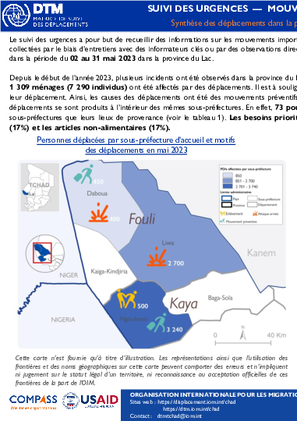
Contact
DTM Chad, dtmtchad@iom.int
Language
English
Location
Chad
Period Covered
May 02 2023
May 31 2023
Activity
- Mobility Tracking
- Event Tracking
Depuis le début de l’année 2023, plusieurs incidents ont été observés dans la province du Lac occasionnant un grand nombre de déplacements. Durant le mois de mai 2023, un total de 1 309 ménages (7 290 individus) ont été affectés par des déplacements. Il est à souligner que la majorité de ces personnes (63%) étaient membres des communautés locales avant leur déplacement. Ainsi, les causes des déplacements ont été des mouvements préventifs (51%), des attaques armées (42%) et des enlèvements des personnes (7%). La plupart des déplacements se sont produits à l’intérieur des mêmes sous-préfectures. En effet, 73 pour cent des personnes déplacées se sont réfugiées dans des localités situées dans les mêmes sous-préfectures que leurs lieux de provenance (voir le tableau 1). Les besoins prioritaires généralement rapportés ont été la nourriture (33%), l’eau (33%), les abris (17%) et les articles non-alimentaires (17%).
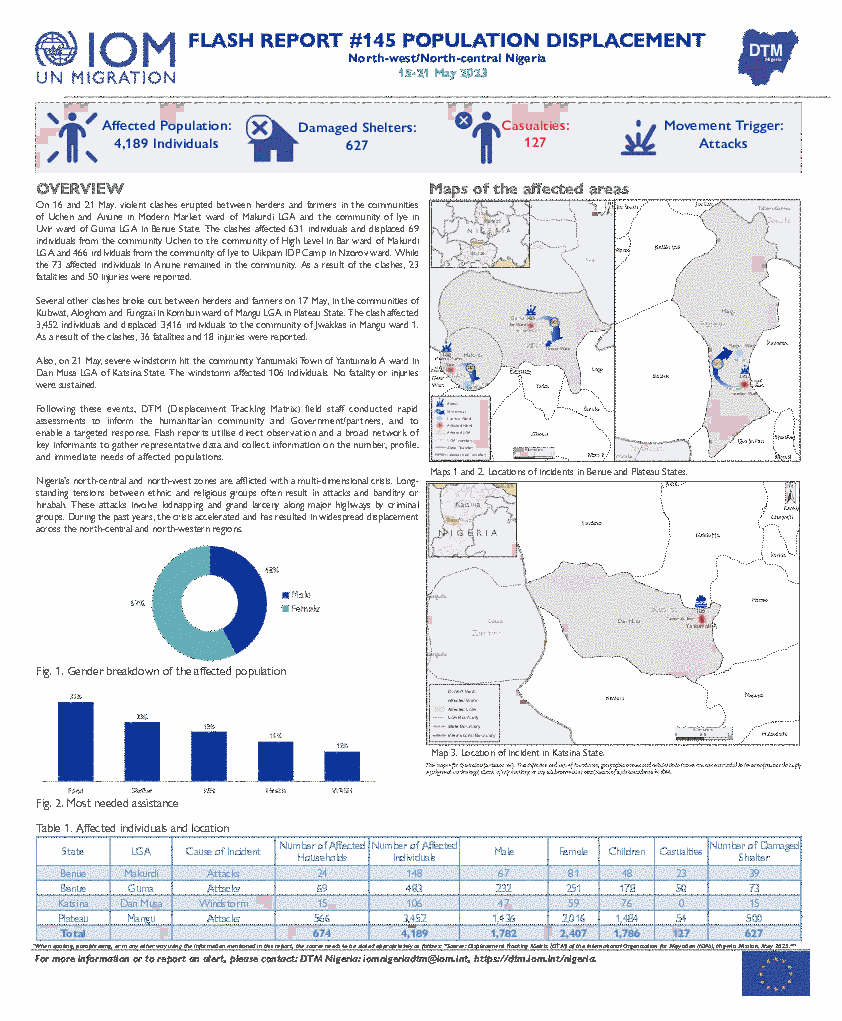
Contact
DTM Nigeria, iomnigeriadtm@iom.int
Language
English
Location
Nigeria
Period Covered
May 15 2023
May 21 2023
Activity
- Mobility Tracking
- Event Tracking
On 16 and 21 May, violent clashes erupted between herders and farmers in the communities of Uchen and Anune in Modern Market ward of Makurdi LGA and the community of Iye in Uvir ward of Guma LGA in Benue State. The clashes affected 631 individuals and displaced 69 individuals from the community Uchen to the community of High Level in Bar ward of Makurdi LGA and 466 individuals from the community of Iye to Uikpam IDP Camp in Nzorov ward. While the 73 affected individuals in Anune remained in the community. As a result of the clashes, 23 fatalities and 50 injuries were reported.
Several other clashes broke out between herders and farmers on 17 May, in the communities of Kubwat, Aloghom and Fungzai in Kombun ward of Mangu LGA in Plateau State. The clash affected 3,452 individuals and displaced 3,416 individuals to the community of Jwakkas in Mangu ward 1. As a result of the clashes, 36 fatalities and 18 injuries were reported.
Also, on 21 May, severe windstorm hit the community Yantumaki Town of Yantumaki A ward in Dan Musa LGA of Katsina State. The windstorm affected 106 individuals. No fatality or injuries were sustained.
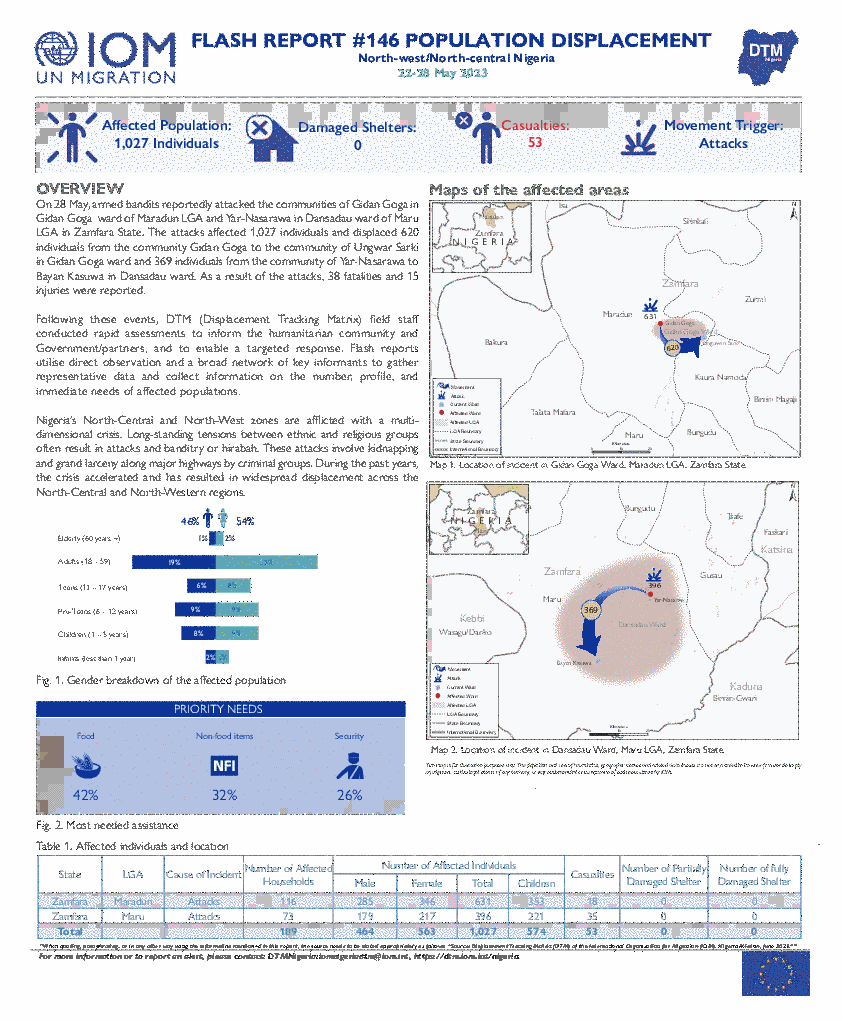
Contact
DTM Nigeria, iomnigeriadtm@iom.int
Language
English
Location
Nigeria
Period Covered
May 22 2023
May 28 2023
Activity
- Mobility Tracking
- Event Tracking
On 28 May, armed bandits reportedly attacked the communities of Gidan Goga in Gidan Goga ward of Maradun LGA and Yar-Nasarawa in Dansadau ward of Maru LGA in Zamfara State. The attacks affected 1,027 individuals and displaced 620 individuals from the community Gidan Goga to the community of Ungwar Sarki in Gidan Goga ward and 369 individuals from the community of Yar-Nasarawa to Bayan Kasuwa in Dansadau ward. As a result of the attacks, 38 fatalities and 15 injuries were reported.

Contact
DTM Nigeria, iomnigeriadtm@iom.int
Language
English
Location
Nigeria
Period Covered
Jan 01 2023
Mar 31 2023
Activity
- Mobility Tracking
- Event Tracking
Between January and March 2023, a total of 26,557 new arrivals had been recorded in many locations in Adamawa, Borno and Yobe States. The new arrivals were recorded at locations in Askira/Uba, Bama, Biu, Damboa, Dikwa, Gubio, Gwoza, Hawul, Kaga, Kala Balge*, Munguno and Ngala Local Government Areas (LGAs) of the most conflict-affected Borno State and in Demsa, Fufore, Girei, Gombi, Hong, Lamurde, Maiha, Michika, Mubi North, Mubi South, Numan, Song, Yola North and Yola South LGAs of Adamawa State; and in Damaturu LGA of Yobe State.
Out of the 26,557 arrivals, 3,113 individuals arrived from the neighboring countries (1,926 from Cameroon, 825 from the Republic of Niger and 362 from the Republic of Chad). Out of these 3,113 individuals, 3,048 are now considered to be IDPs as they are Nigerian nationals who sought refuge in the neighboring countries and now integrated in Banki, GSS, Rann, Transit and Waterboard Camps. The remaining 65 individuals are considered as returnees as they returned to their communities of origin. 23,278 individuals arrived from other locations within the North East.
ETT assessments identified the following movement triggers: poor living conditions (14,372 individuals or 54%), improved security (4,556 individuals or 17%), access to humanitarian support (2,679 individuals or 10%), military operations (1,173 individuals or 4%), family re-unification (1,152 individuals or 4%), Conflict/attacks (1,018 individuals or 3%), seasonal farming (805 individuals or 3%), camp closure (659 individuals or 3%), fear of attacks (125 individuals or 1%), flood (10 individuals or <1%) and voting (8 individuals or <1%).
Bama LGA recorded the highest number of arrivals with 7,834 individuals or 29 per cent of the total individuals, which was followed by Gwoza LGA with 4,261 individuals or 16 per cent. Meanwhile, Hawul LGA recorded the least arrivals with 21 individuals or less than one per cent.

Contact
DTM Europe, DTMMediterranean@iom.int
Language
English
Location
Latvia
Period Covered
Jan 01 2023
Mar 31 2023
Activity
- Survey
- Flow Monitoring
This report is based on a survey of displacement patterns, needs and intentions conducted by IOM’s Displacement Tracking Matrix (DTM) in the 11 countries included in the Regional Response Plan for Ukraine in 2023: 6 countries neighbouring Ukraine – Belarus, Hungary, Poland, Republic of Moldova, Romania and Slovakia – and other 5 countries particularly impacted by the arrivals of refugees from Ukraine since the start of the war in February 2022 – Bulgaria, Czechia, Estonia, Latvia and Lithuania.
Key findings:
•Top oblasts of origin: Kharkivska (19%), Luhanska (17%), Donetska (17%), Zaporizka (10%), Khersonska (9%).
• Intentions to move: 36% have no intentions to move, 35% want to move to a different country (Top 3 destinations were: Germany, Poland, and Finland), 9% would like to get back to their region of origin in Ukraine, 7% want to move to another location in Ukraine, 1% expressed a wish to move within Latvia.
• Employment status: employed (17%), unemployed and looking for a job (17%), unemployed and not looking for a job (17%), retired (19%), self-employed (8%), student (5%), daily worker (4%), on a maternity/ paternity leave (3%).
• Top needs upon return:* housing (41%), cash support (40%), employment (35%), information (21%), transportation (15%), medical needs (10%), trainings (5%).
• Top areas of assistance received:* food products (90%), transportation (60%), personal hygiene and sanitary supplies (48%), clothes and shoes (34%), long-term accommodation (30%), financial support (22%), toys (13%).
• Top inclusion challenges:* financial issues (36%), language barrier (32%), employment (28%), racism (21%), housing (19%), information (15%), documentation (13%), recognition of disabilities (13%).
* more than one answer possible
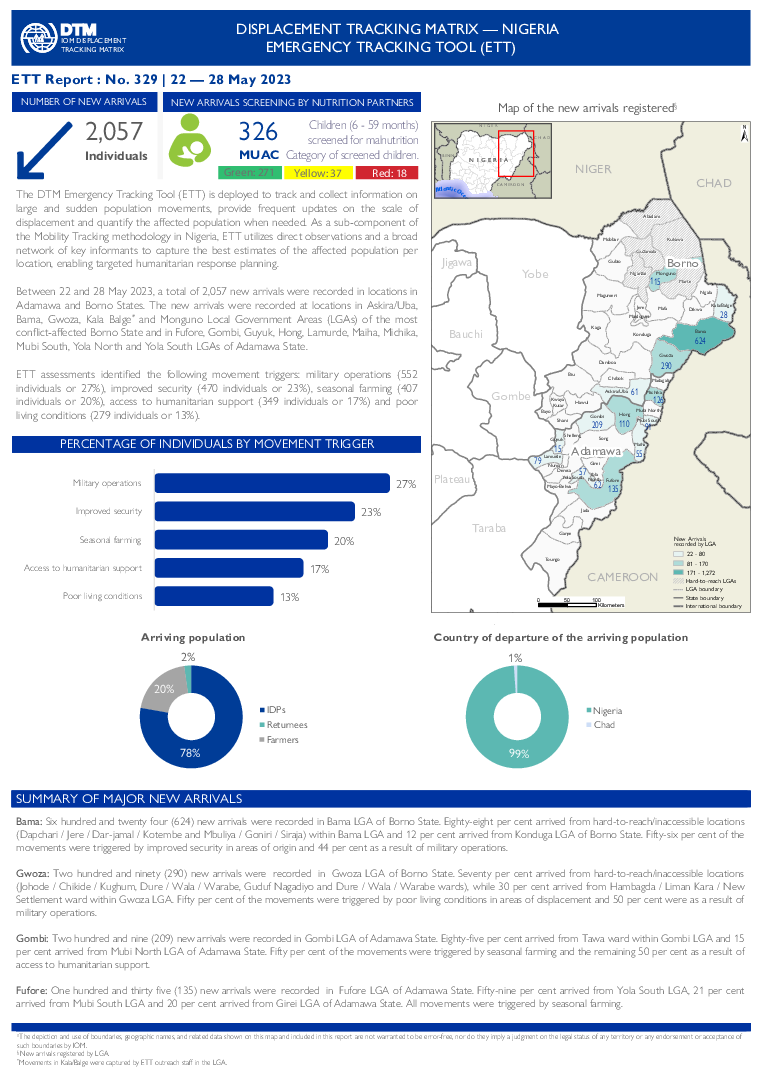
Contact
DTM Nigeria, iomnigeriadtm@iom.int
Language
English
Location
Nigeria
Period Covered
May 22 2023
May 28 2023
Activity
- Mobility Tracking
- Event Tracking
The DTM Emergency Tracking Tool (ETT) is deployed to track and collect information on large and sudden population movements, provide frequent updates on the scale of displacement and quantify the affected population when needed. As a sub-component of the Mobility Tracking methodology in Nigeria, ETT utilizes direct observations and a broad network of key informants to capture the best estimates of the affected population per location, enabling targeted humanitarian response planning.
Between 22 and 28 May 2023, a total of 2,057 new arrivals were recorded in locations in Adamawa and Borno States. The new arrivals were recorded at locations in Askira/Uba, Bama, Gwoza, Kala Balge* and Monguno Local Government Areas (LGAs) of the most conflict-affected Borno State and in Fufore, Gombi, Guyuk, Hong, Lamurde, Maiha, Michika, Mubi South, Yola North and Yola South LGAs of Adamawa State.
Contact
DTM Sudan, DTMSudan@iom.int
Location
Sudan
Activity
- Mobility Tracking
- Baseline Assessment
Period Covered
Apr 15 2023 -Jun 04 2023
From 15 April 2023, armed clashes erupted between the Sudanese Armed Forces (SAF) and the Rapid Support Forces (RSF) in multiple cities across Sudan, including Khartoum, Al Fasher, Kebkabiya, Merowe, Nyala, Zalingi, Ag Geneina, and El Obeid. DTM Sudan has been receiving reports of widespread displacement across different states in Sudan due to the ongoing security situation.
- Since 15 April 2023, DTM estimates that approximately 1,428,551 individuals (286,207 households) have been displaced internally as a result of the conflict.
- Notably, the current estimate for displacement in the previous 52 days is greater than that of recorded displacement during the previous 4 years.
Furthermore, an estimated additional 476,811 individuals have crossed into neighbouring countries.
Due to the ongoing nature of the fighting, many areas reportedly remain inaccessible to humanitarian actors. DTM estimates of displacement are based on preliminary reports from field teams and should be taken as estimations only. Additional reports of displacement are likely to emerge as the situation becomes clearer.
Population Groups
Survey Methodology
Unit of Analysis Or Observation
Type of Survey or Assessment
Keywords
Geographical Scope
Administrative boundaries with available data
The current dataset covers the following administrative boundaries

Contact
dtmuganda@iom.int
Language
English
Location
Uganda
Period Covered
Feb 01 2023
Feb 28 2023
Activity
- Flow Monitoring
In February 2023, 50,362 movements were tracked at nine Flow Monitoring Points (FMPs) at the Ugandan border with Kenya, the Democratic Republic of Congo, the United Republic of Tanzania, Rwanda and South Sudan. These locations were chosen strategically as major transit points for monitoring cross-border movements after the Ministry of Health had declared an outbreak of Sudan Ebola Virus (SVD) at Mubende Regional Referral Hospital (MRRH) in Mubende district on 20 September 2022.
Most people were leaving Uganda (75%) mostly due to economic factors (45%), while around one quarter (26%) were returning to their habitual place of residence. It is important to highlight that 11 per cent of people tracked were children, while there were 780 pregnant or lactating women.
